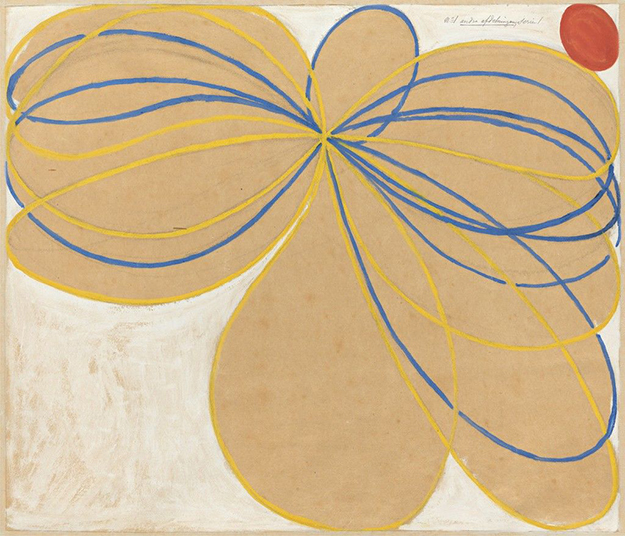News to Me: Cannes, New York, and Notre Dame
 Hilma af Klint, Group V, The Seven-Pointed Star, No. 1n (Grupp V, Sjustjarnan, nr 1), from The WUS/Seven-Pointed Star Series (Serie WUS/Sjustjarnan), 1908. The Hilma af Klint Foundation, Stockholm. Photo: Albin Dahlström, the Moderna Museet, Stockholm
Hilma af Klint, Group V, The Seven-Pointed Star, No. 1n (Grupp V, Sjustjarnan, nr 1), from The WUS/Seven-Pointed Star Series (Serie WUS/Sjustjarnan), 1908. The Hilma af Klint Foundation, Stockholm. Photo: Albin Dahlström, the Moderna Museet, Stockholm
1. The Cannes Film Festival has finally announced their competition lineup, featuring such familiar names as Dardenne(s), Dolan, and Desplechin. However, new to the mix (and new for the festival itself) is Mati Diop, the first black woman to have a film screen in competition. Her film, Atlantique, is an adaptation of her 2009 short, Atlantiques, which we covered in this 2014 article: “The Films of Mati Diop” by Genevieve Yue. (See also this Cinema Scope interview, where Diop shows love for James Baldwin and Claire Denis.)
2. Last week, New York State Governor Andrew Cuomo announced that Netflix plans to expand their NYC presence exponentially. This includes a larger corporate office in Manhattan as well as six soundstages to be built in Brooklyn. “The expansion of this cutting-edge company in New York once again demonstrates the Empire State is open for business,” Cuomo said. The announcement follows quickly on the heels of Cuomo’s recent threat to cut the state’s $420 million Film Tax Credit Program.
3. Speaking of Netflix in New York, Steven Soderbergh’s latest film High Flying Bird focuses on a new Knicks recruit and his agent’s search for agency. Over at the Los Angeles Review of Books, Derek Nystrom delves into Marx, Lukács, and Harry Edwards’s The Revolt of the Black Athlete to offer 13 new perspectives on the film, writing: “if High Flying Bird is about the class struggle, it doesn’t show us that struggle. In fact, the film’s true subject might just be why it is unable to show us the class struggle.” (For more on High Flying Bird, see our interview with its star and co-producer André Holland, by Tayler Montague and our onstage Film Comment Presents discussion with Holland, playwright and screenwriter Tarell Alvin McCraney, and co-star Zazie Beetz.)
4. The Guggenheim’s Hilma af Klint exhibition comes to an end on April 23. Over at Artsy, Julia Wolkoff writes that the late artist’s residency at the museum fulfills Klint’s vision of “inhabiting such a spiralled environment . . . a design for her own temple to house her life’s work.” Fans of Personal Shopper will be familiar with the early abstract artist thanks to the film’s brief expositional lecture (viewed secondhand on a phone screen). In an interview with i-D, Assayas stated that he “wanted to make a film about the invisible”—not as something scary or foreboding but rather, “an inspiration, as it was for the great work of Klint.”
5. It was Claire Denis’s birthday on Sunday, and to celebrate we bring you two fine pieces of Monday reading: this charming conversation with Moonlight’s Barry Jenkins (a self-outed Denis obsessive); and an essay by Darren Hughes on the idea of “a Claire Denis film” (which opens with a neat bit of Film Comment history, to which we would add our beautiful May/June 2000 Beau Travail cover and the Best of 1999 list in our January/February 2010 issue).
6. “Among the tourists, I even detected a guilty sense of good fortune that they’d planned their visits to Paris for this week of all possible weeks. I wanted to ask the locals what the cathedral had meant to them.” Whether thanks to Before Sunset or Quasimodo, Notre Dame holds a special place in many a cinephile’s heart. Chris Knapp of The Paris Review writes on the strange feeling of witnessing the recent catastrophic fire firsthand, referencing many of the same difficult negotiations present in this Aeon essay: “In Defence of Disorder.”
7. In his time, Charlie Chaplin went to painstaking lengths to preserve his own personal archive—complete with poems, drawings, contracts, letters, and other unique souvenirs. Now, thanks to the work of the Bologna Film Library Foundation, much of the Little Tramp’s history is available online, spanning from his early stage career in England to his final days in Switzerland.
8. To celebrate the release of Hannah Frank’s posthumous Frame by Frame: A Materialist Aesthetics of Animated Cartoons (reviewed in our March/April 2019 issue), Light Industry is hosting a reading/screening/lecture on May 7, set to include excerpts from the book as well as films by Disney, Warner Bros., and Robert Breer. Frank’s work is “at once a formal analysis, a labor history of an art formed on the assembly line, an intervention in film theory, and a reflection on Walter Benjamin, Sergei Eisenstein, [and] Susan Howe.”
9. We recently posted this archival Kent Jones piece in praise of Francis Ford Coppola. In it, Jones talks about “the exhaustively documented ordeal of Apocalypse Now,” which, though well-known to some, can all be found neatly compiled here—a resource complete with maps, interviews, and a less-than-sober Dennis Hopper. (Apocalypse Now didn’t make this list of Jones’s influences, though The Godfather does get a mention.)
10. Sight & Sound have concluded their two-part video essay on the history of blackface in film. Beginning, you might have guessed, with D.W. Griffith’s Birth of a Nation, and touching on such films as Bamboozled, Tropic Thunder, and The Party, Leigh Singer covers a number of objectionable Western practices, concluding with the more recent controversies over Disney’s live-action casting.







